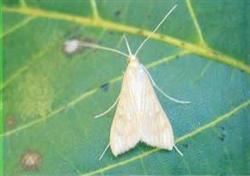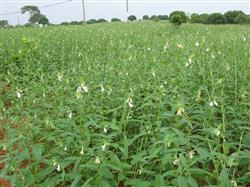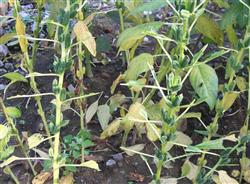What is the sesame pod borer?

What is the sesame pod borer? Please introduce that sesame pod borer is one of the main pests of sesame. Mainly harmful to sesame seeds. Generally occurs in Henan, Hubei, Anhui, Jiangxi and other major sesame producing areas, generally reduce production by 10% to 20%, serious up to 30%, resulting in a significant decline in the quality of sesame. In view of the occurrence, we should seriously study the occurrence law, do a good job in the screening of control agents, and discuss its prevention and control methods. 1. The occurrence regularity of sesame pod borer occurs 4 generations a year in Henan, with generations overlapping and overwintering with mature larvae. Adults appeared from late July to late November, and the peak period was in the first ten days of August. Adults have phototaxis, mostly rest in the back of sesame leaves or weeds during the day, lay eggs at night, and lay eggs scattered on sesame leaves, stems, flowers, capsules and tender shoots. The egg period is 6-7 days. The larvae have the habit of migration, feed on mesophyll and like to drill into the flower heart and capsule to do harm. The larval stage is about 15 days, and the mature larvae pupate with a thin gray cocoon in the rolled leaves, in the capsule or between the stem seams, and the pupal stage is about 7 days. It takes 3738 days to complete a generation. Second, the symptom larvae spin silk to wind the flowers and leaves, feed on the mesophyll, and often drill into the heart of the flower, tender stems and capsules to feed. The seeds can be eaten up, the capsules turn black and fall off, and the plants are withered and yellow. 3. Morphological characteristics: the adult of sesame pod borer is 7mm long and yellowish brown, with three inconspicuous chloasma near the front and two inconspicuous black spots on the hind wing. The egg is about 0.4 mm long, oblong, milky white at first and then yellowish to pink. The larva has a body length of 16 mm, a dark brown head and a green, yellowish green, grayish yellow and reddish brown body color. The pupa is about 10 mm long, grayish green to dark green-brown, and the ends of the beak and antennae are separated from the body. Fourth, prevention and control methods 1. Agricultural control: remove land, roadside, field weeds and litter. Rational rotation, flood and drought rotation should be carried out in areas where conditions permit. Intensive ploughing and raking to reduce the source of overwintering insects. Irrigation at seedling stage and flowering stage to improve soil moisture. two。 Chemical control: (1) fumigation: during the peak period of adults in early August, 80% dichlorvos 100g 150g mixed with sawdust and wheat bran 4kg, 40 piles per mu, evenly piled under sesame trees, the efficacy can be maintained for 8 days. (2) spraying: the peak hatching period of larvae is 7-10 days after the peak of adult, and the control effect of spraying is the best at this time. Kill 30ml EC with 2.5% enemy per mu, 20ml EC with 20% butyl EC, or 25ml EC with 50 fenitrothion EC, add 50kg of water, dilute and spray evenly. (3) dusting: during the peak hatching period of larvae, 1.5% dimethoate powder, 2.5% trichlorfon powder and 2% borer pine powder were sprayed evenly with a powder sprayer. Click to get more sesame planting techniques click to get more food crop planting techniques
- Prev

How to apply micro-fertilizer to grow sesame?
How to apply micro-fertilizer to grow sesame? Please give guidance to the main trace elements needed in the process of sesame growth and development, such as boron, zinc, manganese, iron and so on, but the absorption amount is different in different growth stages, the absorption rate is slow in the seedling stage, and the accumulation quantity is large from flowering to capping stage.
- Next

How to control sesame mosaic disease
How to prevent sesame mosaic disease? Please guide the distribution and damage of sesame mosaic disease: it mainly occurs in Henan, Hubei, Jiangxi, Anhui and other sesame producing areas. There are two types: common mosaic type and wrinkled mosaic type. It is caused by turnip mosaic virus (TuMV) and a globular virus (CMV) alone or in combination.
Related
- The first cup of black tea in spring, the flavor and history of tea gardens in Kenya, Africa
- The computer can not only choose potatoes, but also grow tea rice. AI will grow winter oolong tea champion.
- It is not only the inflated tea bitten by insects, but also engraved with the four seasons tea in Beipu.
- The Oriental Beauty Tea Festival in Zhuxian County takes the stage at the weekend to experience the plus-size feast of oil tea.
- & quot; Oriental Beauty Tea & Exploration of Emei in Hsinchu, the hometown of quot;
- The new variety of strawberry "Tainong 1" dessert is the first choice with mellow aroma. Crimson gorgeous
- History of Tea in Taiwan: from Wild Inner Mountain to Export Tea Garden
- Two types of Taiwan Oriental Beauty Black Tea won the British three-Star Award for Childhood Tea Xiang Zhang Jiaqi changed from pilot to champion tea maker.
- Banana species and varieties: the planting history of Taiwan Xianren banana and dwarf banana is long, is banana disease resistant?
- Coffee planting Technology: Qianjie Coffee from Seedling to harvesting

